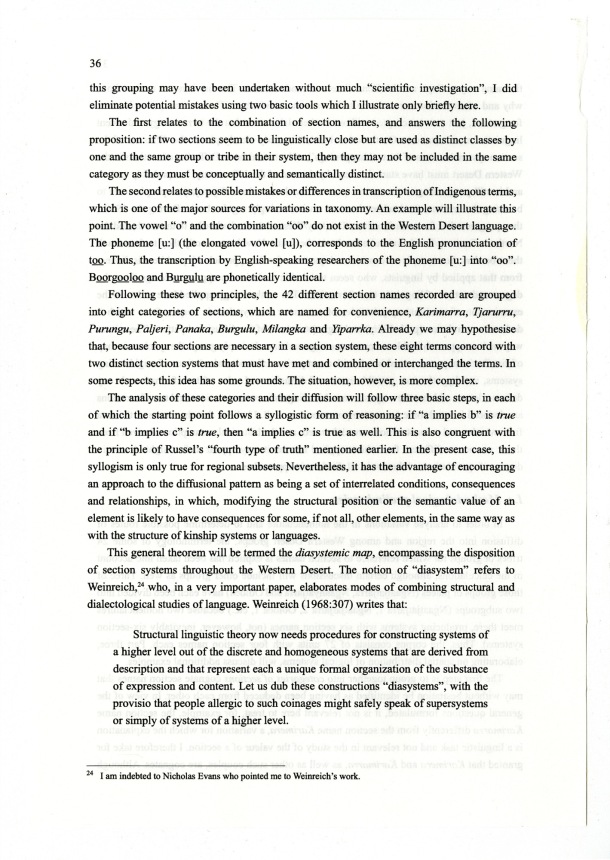|
| 
[Note: this transcription was produced by an automatic OCR engine]
36
this grouping may have been undertaken without much “scientific investigation”, I did
eliminate potential mistakes using two basic tools which I illustrate only briefly here.
The first relates to the combination of section names, and answers the following
proposition: if two sections seem to be linguistically close but are used as distinct classes by
one and the same group or tribe in their system, then they may not be included in the same
category as they must be conceptually and semantically distinct.
The second relates to possible mistakes or differences in transcription of Indigenous terms,
which is one of the major sources for variations in taxonomy. An example will illustrate this
point. The vowel “o” and the combination “oo” do not exist in the Western Desert language.
The phoneme [u:] the elongated vowel [u], corresponds to the English pronunciation of
to_o. Thus, the transcription by English-speaking researchers of the phoneme [uz] into “oo".
Bflrgfllg and Bgrgglg are phonetically identical.
Following these two principles, the 42 different section names recorded are grouped
into eight categories of sections, which are named for convenience, Karimarra, Ijarurru,
Purungu, Paljeri, Panaka, Burgulu, Milangka and Yiparrlm. Already we may hypothesise
that, because four sections are necessary in a section system, these eight terms concord with
two distinct section systems that must have met and combined or interchanged the terms. In
some respects, this idea has some grounds. The situation, however, is more complex.
The analysis of these categories and their diffusion will follow three basic steps, in each
of which the starting point follows a syllogistic form of reasoning: if “a implies b” is true
and if “b implies c” is true, then “a implies c” is true as well. This is also congruent with
the principle of Russel’s “fourth type of truth” mentioned earlier. In the present case, this
syllogism is only true for regional subsets. Nevertheless, it has the advantage of encouraging
an approach to the diffusional pattern as being a set of interrelated conditions, consequences
and relationships, in which, modifying the structural position or the semantic value of an
element is likely to have consequences for some, if not all, other elements, in the same way as
with the structure of kinship systems or languages.
This general theorem will be tenned the diasystemic map, encompassing the disposition
of section systems throughout the Western Desert. The notion of “diasystem” refers to
Weinreich,“ who, in a very important paper, elaborates modes of combining structural and
dialectological studies of language. Weinreich 1968307 writes that:
Structural linguistic theory now needs procedures for constructing systems of
a higher level out of the discrete and homogeneous systems that are derived from
description and that represent each a unique formal organization of the substance
of expression and content. Let us dub these constructions “diasystems”, with the
provisio that people allergic to such coinages might safely speak of supersystems
or simply of systems of a higher level.
7”’ I am indebted to Nicholas Evans who pointed me to Weinreich‘s work.
|